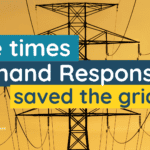
Amsterdam, 25 July 2023 – As we navigate the energy transition, the electricity grid is undergoing substantial changes. The shift from fossil fuel reliance to electrification and the integration of renewable energy sources pose challenges for maintaining grid balance. This is an important topic in all industries, as well as within the activities of the EU Commission.
“To reach our energy and climate targets, the deployment of renewables will need to triple by the end of this decade.”
EU Commission.
As renewables do not produce a consistent output of energy, the balancing of demand and supply on the grid is harder to achieve. Unlike fossil fuels, which can be adjusted to the market’s needs, renewable sources like wind and solar are dependent on weather conditions and cannot be controlled. This creates a greater difficulty in matching the amount of electricity needed with the amount available [1]. In the future, this challenge will become even more significant, as the proportion of electricity generated from renewables is expected to nearly triple by 2030 [2].
EU Market Design
For over twenty years, the European Electricity system has been operating with shared energy market rules and cross-border infrastructure. This Electricity Market Design has achieved an integrated EU electricity market, prioritising secure, sustainable and affordable electricity for EU citizens [3]. In particular, the 2019 Clean Energy for all European citizens package established the principles to create a more flexible, more market-based and more consumer-centric electricity market, allowing access to demand response through aggregation in all electricity markets.
The height of the energy crisis last year has highlighted that the need for non-fossil flexibility in the European electricity market is bigger than foreseen. In addition to allowing more renewable energy sources on the grid, non-fossil flexibility reduces dependence from gas peaking plants and foreign gas imports. Therefore, among other measures, the European Commission has proposed to strengthen the current Electricity Market Design to accommodate non-fossil flexibility and the integration of renewable energy technologies through a market reform.
Market Design Reform
The European Commission reform proposal can be summarised into two main pillars: addressing the supply side by incentivizing longer-term contracts, as well as the demand side by inviting more flexible solutions into the system. The latter prioritises the implementation of storage systems and demand response.
The prioritization of more flexible solutions on the demand side stems from the realisation that the European electricity system needs more flexibility to remain balanced. Member States will be required to report needs and objectives about flexibility and will receive more funding opportunities to introduce demand response mechanisms. This incentive on the demand side will strengthen the possibilities to balance the electricity grid in Europe, while reducing gas dependency and allowing more renewable energy sources on the grid.
The actual elements from the market reform proposal that will influence the current market design and regulation of demand response and flexibility usage are:
New peak shaving product
A new peak shaving product will be introduced to help reduce electricity demand during peak hours. It can be used by the system operators to mitigate situations of critical high prices, reducing the stress on the system and ultimately on consumers.
Dedicated Metering devices
System operators will have the possibility of using data from dedicated metering devices to measure and settle demand response and flexibility services, including storage systems. This allows greater participation of consumers, especially those that are not yet equipped with a smart boundary metre.
New tariff methodologies
Tariff methodologies for system operators will have to consider both capital and operational costs. This means that they have to consider the operational costs of the grid, when they design the fees charged to consumers. Flexibility services, such as demand response, play a significant role in reducing the operational costs of system operators. As a result, by incorporating operational costs into their tariff methodology, system operators are incentivized to procure more flexibility services and make efficient investments in grid optimization.
Report of flexibility needs
Member States will have to assess and report on the flexibility needs of their countries’ electricity systems every two years, starting from January 2025. The reports will include the potential for non-fossil flexibility like demand response and storage. Each state should set a goal for demand response and storage based on these reports.
Flexibility support schemes
Member States that use capacity mechanisms should consider the promotion of non-fossil flexibility like demand response or storage. Capacity mechanisms are operations in place by the transmission system operator to make sure there is enough capacity on the grid to meet the demand. If capacity mechanisms are not enough to meet national flexibility goals, flexibility support schemes can be introduced. These schemes will provide funding for non-fossil flexibility capacity from demand response and storage.
Decrease of minimum bid sizes in day-ahead & intraday markets
The minimum bid sizes for trading in day-ahead and intraday markets will be reduced to 100 kW or less. This change aims to make it easier for small decentralized assets to participate in all electricity markets.
Following the publication of the European Commission proposal, The Council of the EU and the EU Parliament started discussing this reform on their respective sides. While the final approval of the reform is still pending, it is encouraging to see that the EU Commission understands the significance of demand response and flexibility. This signifies a positive step towards their deployment in the electricity system.
ITRE Committee of the European Parliament Position
On 19th of July, ITRE Committee of the European Parliament backed a deal to support non-fossil flexibility and energy storage. ITRE’s position introduces new provisions to support the deployment of flexible technologies. Member States would now have the powers to set up, besides capacity mechanisms, non-fossil flexibility support schemes, which provide stronger business cases for the development of storage and flexible resources. Additionally, EU countries must now assess the flexibility needed in the electricity system to deploy further sources of renewable energy in line with 2030 climate goals, and set a national objective for energy storage. The Commission will also introduce a Strategy for Energy Storage from 2025, to ensure a harmonised approach across the EU.
The result of ITRE’s vote is a positive step towards a better alignment of Europe’s electricity market on meeting climate and energy goals. The introduction of flexibility support schemes will support the participation of demand-side flexibility in new markets, and boost confidence in flexible technologies’ ability to provide the flexibility needed to integrate further renewable energy.
The Council (i.e. Member States) has yet to adopt its position on the revision. Once it does, negotiations can begin. We hope Member States will follow the lead/direction of the European Parliament, and support the development of flexibility.
Author: Mathilde Chareyron – Public and Regulatory Affairs manager at Sympower
Footnotes:
[1] – Denholm, P., Ela, E., Kirby, B., & Milligan, M. (2010). The Role of Energy Storage with Renewable Electricity Generation. http://www.osti.gov/bridge
[2] – European Commission. (2023). Reform of the EU electricity market design. https://ec.europa.eu/commission/presscorner/detail/en/IP_23_1591
[3] – European Commission. (2022). Electricity market design. https://energy.ec.europa.eu/topics/markets-and-consumers/market-legislation/electricity-market-design_en
____________________________________________________________________
Sympower is dedicated to creating a fully renewable energy system. We are the energy experts with years of experience in demand response and flexibility optimisation. Our goal is to turn the potential of your energy assets into extra revenue for you. We provide the technical expertise, all while you stay in control.



















